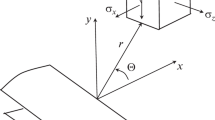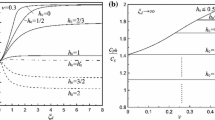The state of the art in modeling the fracture process in various bodies with cracks is critically analyzed. Theoretical approaches to the adequate description of the fracture behavior of bodies due to crack propagation observed experimentally are considered. The potentials of various approaches to the improvement of modern models are evaluated. The problem of the equilibrium state of a nonlinear elastic body with a central mode I crack under biaxial tension is solved. The effect of tensile stresses acting along the crack on its opening displacement and shape of the nonlinear zone is examined
Similar content being viewed by others
References
V. L. Bogdanov, A. N. Guz, and V. M. Nazarenko, “Stress–strain state of a material under forces acting along a periodic set of coaxial mode II penny-shaped cracks,” Int. Appl. Mech., 46, No. 12, 1339–1350 (2010).
P. W. Bridgman, “Recent work in the field of high pressures,” Rev. Modern Physics, 18, No. 1, 1–93 (1946).
P. M. Vitvitskii, V. V. Panasyuk, and S. Ya. Yarema, ”Plastic deformation in the vicinity of a crack and the criteria of fracture (a review),” Strength of Materials, 5, No. 2, 135–151 (1973).
I. I. Goldenblatt, Some Problems of the Mechanics of Deformable Media, Noordhoff, Groningen (1962).
A. N. Guz, A. A. Kaminsky, and V. M. Nazarenko, Fracture Mechanics, Vol. 5 of the 12-volume series Mechanics of Composite Materials [in Russian], ASK, Kyiv (1996).
A. A. Il’yushin, ”Some issues of plastic deformation theory,” Prikl. Mat. Mekh., 7, No. 4, 245–272 (1943).
A. A. Kaminsky and D. A. Gavrilov, Delayed Fracture of Polymeric and Composite Materials with Cracks [in Russian], Naukova Dumka, Kyiv (1992).
A. A. Kaminsky, G. I. Usikova, E. E. Kurchakov, E. A. Dmitrieva, and S. P. Doroshenko, ”Experimental study of the plastic zone near a crack tip,” Probl. Mashinostr. Avtomatiz., No. 6, 79–85 (1991).
A. A. Kaminsky, G. I. Usikova, and E. A. Dmitrieva, ”Experimental study of the distribution of plastic strains near a crack tip during static loading,” Int. Appl. Mech., 30, No. 11, 892–897 (1994).
A. A. Kaminsky, L. A. Kipnis, and V.A. Kolmakova, ”On the Dugdale model for a crack at the interface of different media,” Int. Appl. Mech., 35, No. 1, 58–63 (1999).
A. A. Kaminsky, M. V. Dudik, and L. A. Kipnis, ”Initial kinking of an interface crack between two elastic media under tension and shear,” Int. Appl. Mech., 45, No. 6, 635–642 (2009).
E. E. Kurchakov, ”Stress-strain relation for nonlinear anisotropic medium,” Int. Appl. Mech., 15, No. 9, 803–807 (1979).
V. V. Panasyuk, Limiting Equilibrium of Brittle Bodies with Cracks [in Russian], Naukova Dumka, Kyiv (1968).
V. Z. Parton and E. M. Morozov, Mechanics of Elastic-Plastic Fracture, Hemisphere, Washington (1989).
M. M. Filonenko-Borodich, Theory of Elasticity, Dover, New York (1965).
L. P. Khoroshun, ”Discretization of the plane problem for a cracked body with nonlinear stress–strain diagram under tension,” Int. Appl. Mech., 46, No. 11, 1238–1252 (2010).
R. Clausius, ”Ueber eine veranderte Form des zweiten Hauptsatzes der mechanischen Warmetheorie,” Annalen der Physic und Chemie, 93, No. 12, 481–506 (1854).
G. P. Cherepanov, Mechanics of Brittle Fracture, McGrow-Hill, New York (1979).
P. P. Cortet, S. Santucci, L. Vanel, and S. Ciliberto, ”Slow crack growth in polycarbonate films,” Europhysics Letters, 71, No. 2, 242–248 (2005).
C. K. Desai, A. S. Kumar, S. Basu, and V. Parameswaran, “Measurement of cohesive parameters of crazes in polystyrene films,” in: Conf. Proc. of the Society for experimental mechanics series (2011), pp. 519–526.
H. Liebowitz (ed.), Fracture. An Advanced Treatise, Vols. 1–7, Academic Press, New York (1968–1974).
A. L. Gain, J. Carroll, G. H., Peulino, and J. Lambros, ”A hybrid experimental/numerical technique to extract cohesive fracture properties for mode-I fracture of quasi-brittle materials,” Int. J. Fract., 169, No. 2, 113–131 (2011).
A. N. Guz, I. A. Guz, A. V. Men’shikov, and V. A. Men’shikov, ”Three-dimensional problems in the dynamic fracture mechanics of materials with interface cracks (review),” Int. Appl. Mech., 49, No. 1, 1–61 (2013).
A. N. Guz, ”Establishing the foundations of the mechanics of fracture of materials compressed along cracks (review),” Int. Appl. Mech., 50, No. 1, 1–57 (2014).
H. Helmholtz, Ueber die Erhaltung der Kraft, Wissenschaftliche Abhandlungen, Reimer, Berlin (1847).
J. W. Hutchison, ”Singular behaviour at the end of a tensile crack in a hardening material,” J. Mech. Phys. Solids, 16, No. 1, 13–22 (1968).
A. A. Kaminsky, ”Long-term fracture mechanics of viscoelastic bodies with cracks,” Int. Appl. Mech., 50, No. 5, 3–79 (2014).
A. A. Kaminsky, ”Subcritical crack growth in polymer composite materials,“ in: G. Cherepanov (ed.), Fracture: A Topical Encyclopedia of Current Knowledge, Krieger Publishing Company, Malabar (1998), pp. 758–763.
A. A. Kaminsky and E. E. Kurchakov, ”Modeling of fracture process zone near a crack tip in a nonlinear elastic body,” Int. Appl. Mech., 47, No. 6, 735–744 (2011).
A. A. Kaminsky and E. E. Kurchakov, ”Modeling a crack with a fracture process zone in a nonlinear elastic body,” Int. Appl. Mech., 48, No. 5, 552–562 (2012).
H. Kauderer, Nichtlineare Mechanic, Springer-Verlag, Berlin (1958).
L. P. Choroshun and O. I. Levchuk, “Stress distribution around cracks in linear hardening materials subject to tension: Plane problem,” Int. Appl. Mech., 50, No. 2, 128–140 (2014).
G. C. Sih, Handbook of Stress Intensity Factors, Lehigh Univ. Press, Bethlehem (1973).
L. V. Voitovich, M. P. Melezhik, and I. S. Chernyshenko, ”Photoelastic modeling of the fracture of viscoelastic orthotropic plates with a crack,” Int. Appl. Mech., 46, No. 6, 677–682 (2010).
A. A. Wells, ”Critical tip opening displacement as fracture criterion,” in: Proc. Crack Propagation Symp., Vol. 1, Cranfield (1961), pp. 210–221.
J. G. Williams, Fracture Mechanics of Polymers, Wiley, New York (1984).
M. P. Wnuk, “Subcritical growth of fracture (inelastic fatigue),” Int. J. Fract. Mech., 7, No. 4, 383–407 (1971).
M. P. Wnuk and W. G. Knauss, “Delayed fracture in viscoelastoplastic solids,” Int. J. Solids Struct., 6, No. 7, 995–1010 (1970).
M. B. Yaffee and E. J. Kramer, ”Plasticization effects on environmental craze microstructure,” J. Mater. Sci., 16, No. 8, 2130–2136 (1981).
T. Yokobori, The Strength, Fracture and Fatigue of Materials, P. Noordhoff, Groningen (1965).
Author information
Authors and Affiliations
Corresponding author
Additional information
Translated from Prikladnaya Mekhanika, Vol. 51, No. 2, pp. 13–33, March–April 2015.
Rights and permissions
About this article
Cite this article
Kaminsky, A.A., Kurchakov, E.E. Influence of Tension Along a Mode I Crack in an Elastic Body on the Formation of a Nonlinear Zone. Int Appl Mech 51, 130–148 (2015). https://doi.org/10.1007/s10778-015-0679-5
Received:
Published:
Issue Date:
DOI: https://doi.org/10.1007/s10778-015-0679-5




